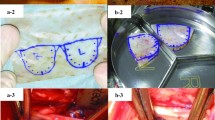Abstract
Extracellular matrices (ECM) are commonly used to repair congenital heart defects; however, there is a lack of literature pertaining to outcomes with ECM use in high-pressure conditions. Between 2011 and 2014, a total of 202 patients underwent congenital heart disease repair using the ECM placed in a systemic pressure condition. The operative sites included: defects in the ventricular septum, mitral valve, aortic valve, ascending aorta, and aortic arch. Patients were followed and evaluated for mortality and reoperations due to loss of ECM integrity. Echocardiograms were evaluated for graft malfunction such as aneurysmal dilation, VSD formation, valve malfunction, or outflow tract obstruction. Patients were followed for an average of 1492 days (Median = 1583). Out of the 202 patients, 7 (3.5%) died due to complications unrelated to ECM, and 10 (5%) underwent reoperations due to complications of ECM integrity. Reoperations were as follows: two of 6 patients receiving aortic leaflet replacement required reoperation for leaflet failure; four of 12 patients receiving mitral valve leaflet repairs required reoperation for leaflet failure; and four of 142 patients with VSD repair required reoperation for residual shunting. The average time to reoperation was 208 days. There were no outflow tract obstructions or aneurysmal dilatations observed. This modern case series suggests that the ECM is efficacious and sustainable under systemic conditions in congenital heart defect repair. However, concerns remain about the use of ECM in aortic valve repair and infant mitral valve repair. Further studies are needed to evaluate long-term ECM integrity.
Similar content being viewed by others
References
Kalfa D, Bacha E (2013) New technologies for surgery of the congenital cardiac defect. Ram Maimonides Med J 4(3):e0019
Mosala Z, Poncelet A, De Kerchove L, Gianello P, Fervaille C (2016) Small intestinal submucosa extracellular matrix (CorMatrix ®) in cardiovascular surgery : a systematic review. Int Cardiovasc Thorac Surg 22:839–850
Padera RF (2014) Preliminary experience with porcine intestinal submucosa (CorMatrix) for valve reconstruction in congenital heart disease: histologic evaluation of explanted valves. J Thorac Cardiovasc Surg 148(5):2216–2225. doi:10.1016/j.jtcvs.2014.02.081
Nelson JS, Heider A, Si M, Ohye RG (2016) Evaluation of Explanted CorMatrix intracardiac patches in children with congenital heart disease. Ann Thorac Surg. doi:10.1016/j.athoracsur.2016.03.086
Woo JS, Fishbein MC, Reemtsen B (2016) Histologic examination of decellularized porcine intestinal submucosa extracellular matrix (CorMatrix) in pediatric congenital heart surgery. Cardiovasc Pathol 25(1):12–17. doi:10.1016/j.carpath.2015.08.007
Yanagawa B, Rao V, Yau TM (2013) Initial experience with intraventricular repair using CorMatrix extracellular matrix. Innovations 8(5):348–352
Brinster DR, Patel JA (2014) The use of CorMatrix extracellular matrix for aortic root enlargement. J Cardiothorac Surg 9:178
Gerdisch MW, Shea RJ, Barron MD (2014) Clinical experience with CorMatrix extracellular matrix in the surgical treatment of mitral valve disease. J Thorac Cardiovasc Surg 148:1370–1378
Zaidi AH, Nathan M, Emani S, Baird C, del Nido PJ, Gauvreau K et al (2014) Preliminary experience with porcine intestinal submucosa (CorMatrix) for valve reconstruction in congenital heart disease: histologic evaluation of explanted valves. J Thorac Cardiovasc Surg 148:2216
Rosario-Quinones F, Magid MS, Yau J, Pawale A, Nguyen K (2015) Tissue reaction to porcine intestinal submucosa (CorMatrix) implants in pediatric cardiac patients: a single-center experience. Ann Thorac Surg 99(4):1373. doi:10.1016/j.athoracsur.2014.11.064
Author information
Authors and Affiliations
Corresponding author
Ethics declarations
Conflict of interest
All authors declare that they have no conflict of interest.
Ethical Approval
This study was approved by the Institutional Review Board at UCLA. The study design was a retrospective chart review of patients, and thus, there were no interventions, or involvement with human or animal subjects. This article does not contain any studies with animals or humans performed by any of the authors.
Informed Consent
This was a retrospective chart review, and thus, no informed consent was needed in this study.
Rights and permissions
About this article
Cite this article
Ashfaq, A., Iyengar, A., Kwon, O.J. et al. Efficacy of an Extracellular Matrix in Systemic Loading Conditions in Congenital Heart Surgery. Pediatr Cardiol 38, 1337–1341 (2017). https://doi.org/10.1007/s00246-017-1666-x
Received:
Accepted:
Published:
Issue Date:
DOI: https://doi.org/10.1007/s00246-017-1666-x




